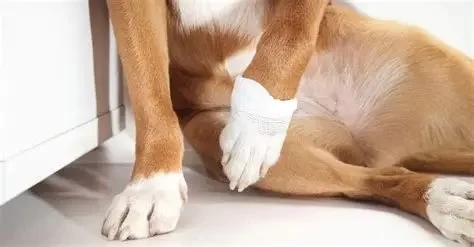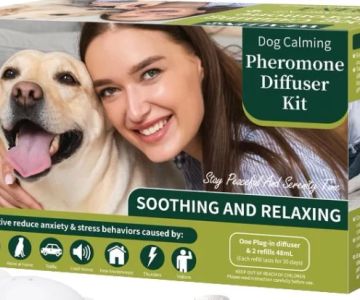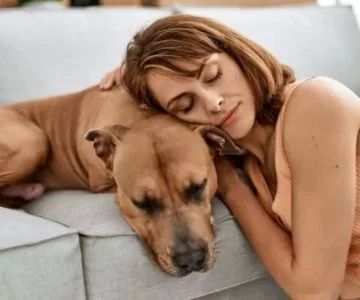Understanding Anxiety in Senior Dogs with Joint Pain
As our beloved dogs age, they can experience a variety of health issues, with joint pain being one of the most common. For senior dogs, this pain often leads to a host of challenges, including anxiety. Joint pain, especially in conditions like arthritis, can make it difficult for dogs to move around comfortably. This discomfort can cause them to become stressed, anxious, or even depressed, which, in turn, affects their overall quality of life.
Reducing anxiety in senior dogs with joint pain is crucial not only for their physical well-being but also for their emotional health. In this article, we will explore the link between joint pain and anxiety in older dogs and provide practical solutions to help alleviate both discomfort and distress.
1. Recognizing the Signs of Anxiety in Senior Dogs with Joint Pain
It's important to identify the signs of anxiety in senior dogs, as they often express stress and discomfort differently than younger dogs. If your dog is suffering from joint pain, anxiety can become more pronounced, especially during activities like walking or climbing stairs.
Common signs of anxiety in senior dogs with joint pain include:
- Restlessness: Dogs with anxiety often cannot relax, pacing around the house or being unable to settle down.
- Excessive Panting: While panting is normal after physical activity, excessive panting without exertion can be a sign of anxiety.
- Whining or Barking: Older dogs may whine or bark when they are in discomfort or feeling anxious, especially if they are struggling with joint pain.
- Changes in Behavior: A senior dog in pain might isolate itself or become more withdrawn, avoiding interaction or becoming irritable.
- Decreased Mobility: If your dog avoids movement, limps, or hesitates to get up, this could indicate joint pain and associated anxiety.
Being observant and recognizing these behaviors is the first step toward helping your dog feel better. If you notice these signs, it may be time to consider ways to reduce both their anxiety and joint discomfort.
2. How Joint Pain Triggers Anxiety in Senior Dogs
Joint pain is a significant issue for senior dogs, often caused by arthritis or other degenerative joint diseases. These conditions can lead to chronic pain, which not only affects their physical movements but also their emotional state. When a dog experiences pain, their ability to engage in normal activities like playing, walking, or even lying comfortably is compromised, which can cause stress and anxiety.
For senior dogs, the pain may be subtle at first, but over time, as the disease progresses, it becomes more pronounced. The anxiety triggered by this pain stems from several factors:
- Inability to Participate in Activities: Dogs love to be active, but when joint pain restricts their movement, it can lead to frustration and stress.
- Fear of Pain: If your dog has experienced pain while moving or engaging in certain activities, they may become fearful of attempting those actions again, heightening anxiety.
- Lack of Comfort: Older dogs may also struggle to find a comfortable position to rest, leading to constant discomfort and agitation.
Understanding how joint pain triggers anxiety in your senior dog is essential for finding the right solutions to help them feel comfortable and calm again.
3. Effective Strategies to Reduce Anxiety in Senior Dogs with Joint Pain
There are several strategies you can implement to help reduce anxiety in senior dogs suffering from joint pain. These solutions focus on both physical and emotional well-being, ensuring that your dog can live a more comfortable and fulfilling life in their golden years.
1. Create a Comfortable Resting Area
Ensure your dog has a quiet, comfortable, and supportive place to rest. Use orthopedic dog beds that relieve pressure on the joints and provide warmth and comfort. A bed with memory foam or a cushioned mat can help ease discomfort and improve their rest, which is crucial for both their physical and emotional health. A calm, comfortable space also helps reduce stress by giving them a sense of security.
2. Use Joint Supplements and Pain Relievers
Joint pain can be alleviated with the right supplements and medications. Omega-3 fatty acids, glucosamine, and chondroitin are popular supplements that can help reduce inflammation and improve joint health. Consult with your vet about the best pain relievers for your dog, such as non-steroidal anti-inflammatory drugs (NSAIDs) or more natural alternatives like CBD oil, which may help ease discomfort without causing further stress.
3. Consider Calming Aids and Techniques
There are several products designed specifically to calm anxious dogs, including:
- Calming Collars or Sprays: These products contain pheromones that mimic the natural calming signals a mother dog gives to her puppies, helping to reduce anxiety.
- Adaptil Diffusers: These release calming pheromones into the air and have been shown to reduce anxiety in dogs.
- Gentle Massage: Massaging your dog’s muscles and joints can reduce tension, ease pain, and calm their nerves. Gentle strokes can help improve blood circulation and promote relaxation.
Incorporating these calming aids can make a significant difference in how your dog handles anxiety caused by joint pain.
4. Maintain a Regular Routine
Dogs thrive on routine, and for senior dogs, predictability helps reduce stress. Try to maintain consistent feeding times, walk schedules, and playtimes to help your dog feel secure. A predictable routine can also help them feel less anxious, especially if they are coping with joint pain.
5. Provide Low-Impact Exercise
Exercise is essential for senior dogs, but high-impact activities may exacerbate joint pain. Instead, provide low-impact exercises like short walks, swimming, or gentle play. These activities can help maintain muscle strength and mobility without putting too much strain on the joints, reducing the anxiety associated with inactivity.
6. Consult with a Veterinarian
If your dog’s anxiety persists, it’s important to consult with your veterinarian. They can assess your dog’s joint health, recommend effective treatment plans, and possibly prescribe medications or therapies to help manage both pain and anxiety. A professional approach ensures that your dog gets the best care possible.
4. Real-Life Story: How Calming Strategies Helped a Senior Dog
Take the story of Daisy, a 12-year-old Labrador Retriever, who had been struggling with arthritis in her hips for months. Daisy’s owners noticed that she became increasingly anxious, especially at night when the pain seemed to intensify. They started by setting up a comfortable, orthopedic bed in a quiet corner of the house and began giving Daisy joint supplements recommended by their vet.
They also incorporated calming techniques, including massage and a calming pheromone diffuser in the home. Over time, Daisy became noticeably less anxious, and her mobility improved as the supplements took effect. The reduction in pain and anxiety allowed Daisy to enjoy her walks again, and she seemed more relaxed and happy overall.
This transformation highlights how a combination of medical treatment, comfort measures, and calming techniques can significantly improve the quality of life for senior dogs suffering from joint pain and anxiety.











